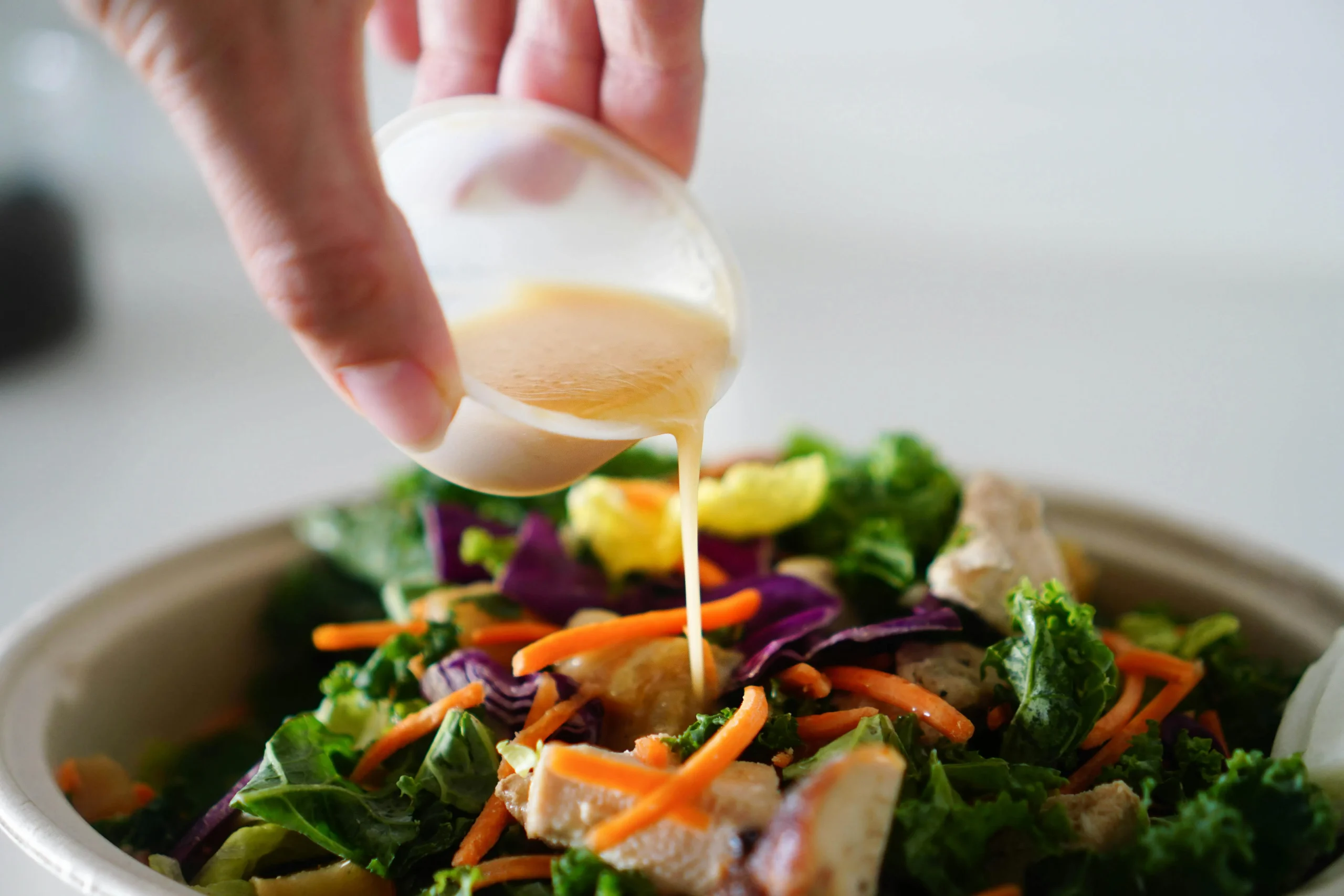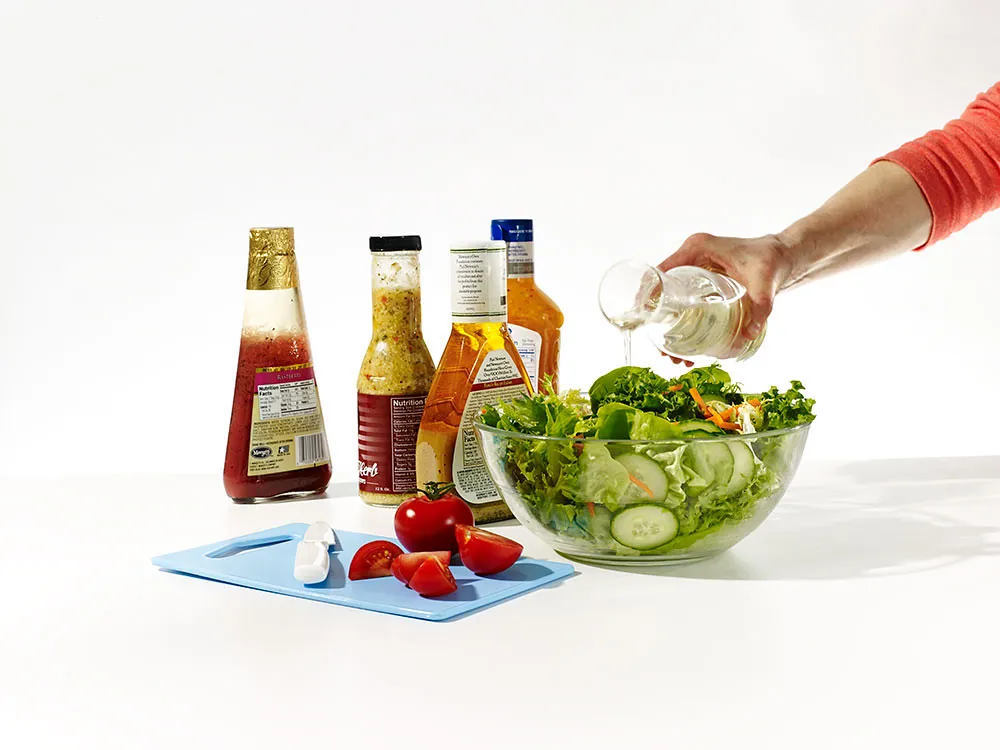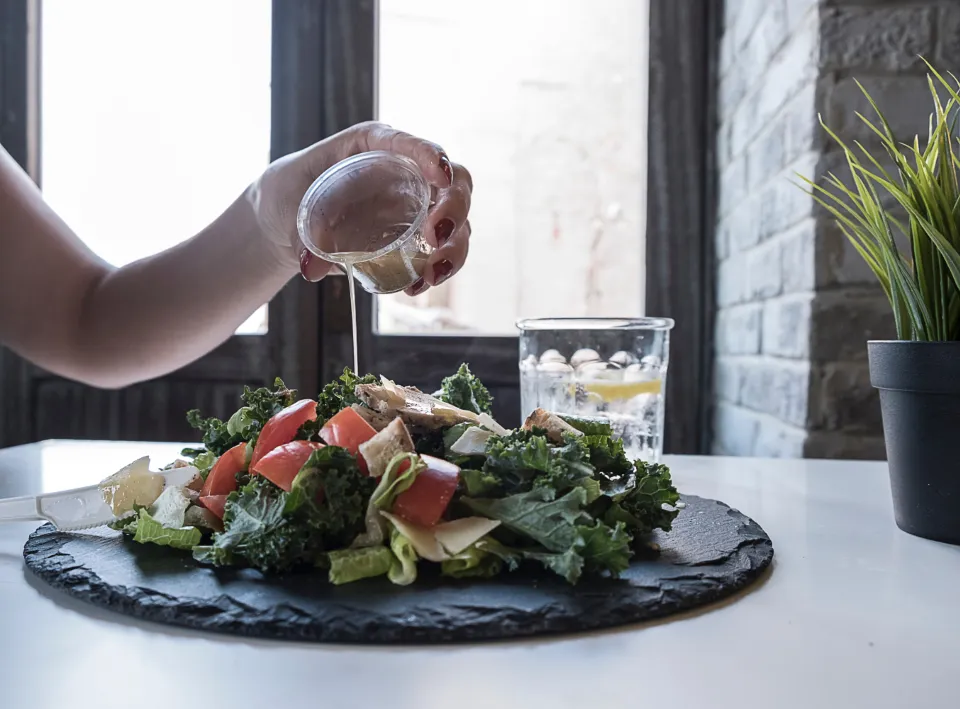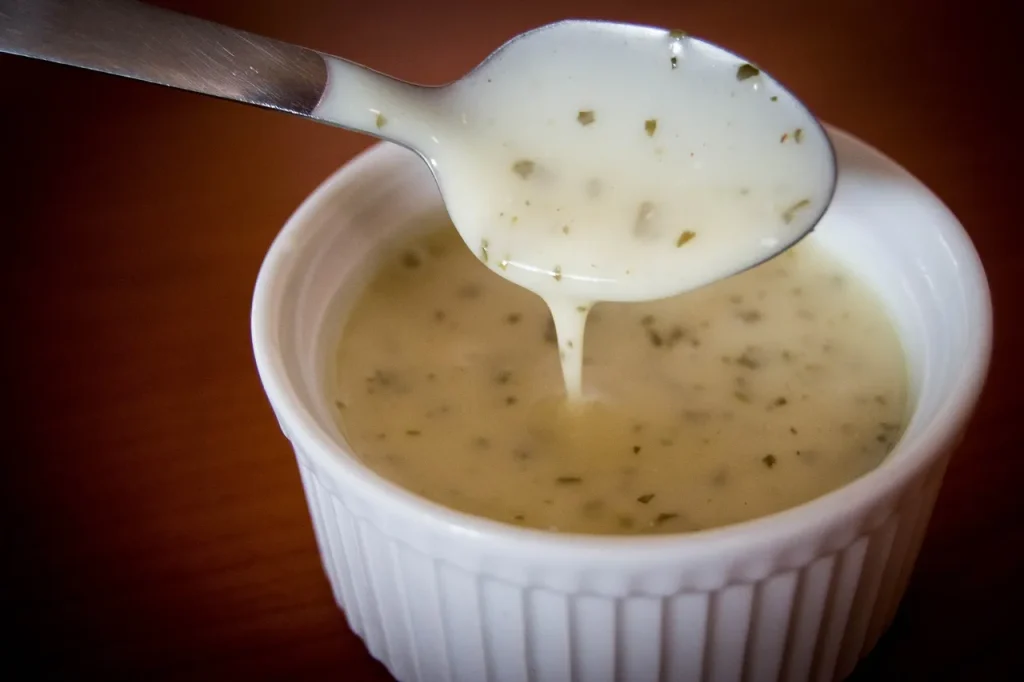The Best Fluffy Pancakes recipe you will fall in love with. Full of tips and tricks to help you make the best pancakes.
Salad dressings can make or break a salad, transforming a simple bowl of greens into a flavorful and satisfying meal. While store-bought dressings often contain artificial ingredients, preservatives, and unnecessary sugars, making your own at home ensures freshness, quality, and total control over the flavors.
Vegan salad dressings are not only healthier but also incredibly easy to prepare. Whether you prefer a tangy vinaigrette, a creamy tahini-based dressing, or a zesty citrus blend, homemade recipes allow you to customize every detail to suit your taste. Plus, using wholesome, plant-based ingredients like olive oil, lemon juice, and nutritional yeast enhances both the flavor and nutritional value of your meals.
In this post, we’ll explore the best easy vegan salad dressing recipes you can make at home. You’ll also learn about the key ingredients, customization tips, and storage hacks to keep your dressings fresh and delicious. Let’s dive in!
Why Choose Vegan Salad Dressings?
Switching to homemade vegan salad dressings offers numerous health benefits while allowing you to control the ingredients. Unlike store-bought dressings, which often contain preservatives, refined sugars, and unhealthy fats, homemade versions are made with whole, plant-based ingredients that are rich in nutrients.
A well-balanced plant-based diet, including fresh and natural dressings, can contribute to overall health and wellness. According to Harvard T.H. Chan School of Public Health, incorporating healthy fats, fresh vegetables, and plant-based proteins into your diet supports heart health and reduces the risk of chronic diseases. By making your own vegan salad dressings, you can ensure that your meals align with these principles while maximizing flavor and nutrition.

Health Benefits of Vegan Dressings
One of the biggest reasons to choose vegan salad dressings is the health benefits they offer. Traditional dressings often contain dairy, refined sugars, and preservatives, which can lead to inflammation and digestive issues. Vegan alternatives, however, use natural ingredients such as olive oil, tahini, apple cider vinegar, and lemon juice, which provide essential nutrients without unnecessary additives.
Here are some key health benefits of vegan dressings:
- Rich in Healthy Fats – Ingredients like avocado, olive oil, and nuts provide heart-healthy monounsaturated fats.
- Nutrient-Dense – Lemon juice, nutritional yeast, and fresh herbs add essential vitamins and minerals.
- Dairy-Free & Gut-Friendly – Vegan dressings are easier to digest, making them ideal for those with lactose intolerance or sensitive stomachs.
- No Artificial Additives – Homemade dressings allow you to skip preservatives and added sugars commonly found in store-bought varieties.
Customizing Flavors for Your Salad
Another advantage of making your own vegan salad dressings is the ability to fully customize flavors to match your personal preference. Whether you enjoy a tangy vinaigrette, a rich and creamy dressing, or something spicy and bold, homemade recipes allow for complete flexibility.
Here’s how you can tailor your dressing to suit your taste:
- For a tangy kick: Use apple cider vinegar, Dijon mustard, or lemon juice.
- For a creamy texture: Blend in tahini, avocado, or cashews.
- For a hint of sweetness: Add maple syrup, agave, or a splash of orange juice.
- For extra spice: Include cayenne pepper, smoked paprika, or garlic for a bold flavor boost.
Environmental Impact of Vegan Ingredients
Choosing vegan salad dressings also supports a more sustainable and eco-friendly lifestyle. Many traditional dressings rely on dairy products, which have a larger carbon footprint due to the environmental impact of animal agriculture. By using plant-based ingredients, you help reduce greenhouse gas emissions, conserve water, and minimize land use.
Here’s how homemade vegan dressings make a positive impact on the environment:
- Lower Carbon Footprint – Plant-based ingredients require fewer resources to produce than dairy and animal-based products.
- Less Plastic Waste – Making dressings at home reduces the need for store-bought bottles, which often come in plastic packaging.
- Support for Sustainable Farming – Using fresh, organic ingredients promotes sustainable agriculture and reduces exposure to pesticides.
By choosing vegan salad dressings, you’re not only making a healthier choice for yourself but also a more ethical and sustainable choice for the planet. With so many delicious and easy homemade recipes available, it’s never been easier to enjoy flavorful salads while staying true to a plant-based lifestyle!
The Best Ingredients for Homemade Vegan Salad Dressings
Creating a delicious vegan salad dressing starts with the right ingredients. Unlike store-bought options that often contain artificial flavors, preservatives, and unhealthy fats, homemade dressings use fresh, plant-based ingredients that enhance both flavor and nutrition. By stocking your kitchen with a few essential items, you can mix and match flavors to create endless dressing variations tailored to your taste.
Let’s take a closer look at the best ingredients to use when making homemade vegan salad dressings.

Staples for Vegan Dressings
A good vegan dressing starts with a balance of acidity, creaminess, and seasoning. Here are some key staples to have on hand:
- Olive Oil – A classic base for vinaigrettes, extra virgin olive oil adds richness and heart-healthy fats.
- Apple Cider Vinegar – Provides a tangy, slightly sweet acidity that pairs well with most salads.
- Lemon Juice – Fresh lemon juice brightens up dressings and adds a refreshing citrus flavor.
- Dijon Mustard – Acts as an emulsifier to help blend oil and vinegar while adding a slight kick.
- Maple Syrup or Agave Nectar – Natural sweeteners that balance out acidity without using refined sugar.
- Garlic & Onion Powder – Enhance depth of flavor in both creamy and vinaigrette-style dressings.
- Nutritional Yeast – Gives a cheesy, umami flavor perfect for Caesar or ranch-style dressings.
By combining these simple ingredients, you can quickly whip up a variety of flavorful, nutritious dressings for any salad.
Healthy Additions for Flavor and Texture
If you want to take your vegan dressings to the next level, adding certain ingredients can enhance their taste and texture:
- Tahini – A creamy sesame paste that adds a nutty depth to dressings, great for Mediterranean-style salads.
- Avocado – Blending avocado into a dressing creates a rich, creamy texture while adding healthy fats.
- Cashews or Almonds – Soaked and blended, these nuts create a thick and velvety dressing without dairy.
- Coconut Milk – A great base for creamy dressings, adding a hint of natural sweetness.
- Fresh Herbs (Basil, Cilantro, Parsley, Dill) – Brighten up dressings and add complexity to the flavor.
- Soy Sauce or Tamari – Adds a savory, umami taste, ideal for Asian-inspired dressings.
- Smoked Paprika or Cumin – Provide a hint of spice and depth to dressings for a smoky, bold flavor.
These ingredients allow you to experiment with different flavors and textures, ensuring your dressings never feel repetitive or bland.
Oil-Free Vegan Dressings
For those looking to reduce their oil intake, there are plenty of ways to create delicious dressings without using oil:
- Blended Nuts or Seeds – Cashews, almonds, sunflower seeds, or hemp seeds create a rich, creamy base.
- Silken Tofu – A great low-fat alternative that makes dressings thick and smooth.
- Aquafaba (Chickpea Water) – Acts as an emulsifier and can replace oil for a lighter dressing.
- Fruit-Based Dressings – Blended mango, pineapple, or strawberries add natural sweetness and a smooth texture.
- Vegetable Purees – Roasted red peppers, carrots, or tomatoes can be blended for a vibrant, oil-free dressing.
These alternatives ensure that even oil-free dressings remain flavorful, creamy, and satisfying.
Quick and Easy Vegan Salad Dressing Recipes
One of the best things about homemade vegan salad dressings is how quick and simple they are to make. With just a few fresh ingredients and a blender or whisk, you can create a variety of flavorful dressings in minutes. Whether you’re looking for a light vinaigrette, a creamy dressing, or something bold and tangy, these easy recipes will elevate any salad.
Below are three delicious and easy-to-make vegan salad dressing recipes that you can prepare at home.

1. Simple Vegan Vinaigrette
A classic vinaigrette is a must-have in any kitchen. This vegan version is tangy, slightly sweet, and perfect for drizzling over fresh greens, roasted vegetables, or grain bowls.
Ingredients:
- ¼ cup extra virgin olive oil
- 2 tablespoons apple cider vinegar (or balsamic vinegar)
- 1 tablespoon Dijon mustard
- 1 teaspoon maple syrup or agave nectar
- 1 clove garlic, minced
- ½ teaspoon sea salt
- ¼ teaspoon black pepper
- 1 tablespoon water (to thin, if needed)
Instructions:
- In a small bowl or jar, whisk together the vinegar, mustard, maple syrup, garlic, salt, and pepper.
- Slowly drizzle in the olive oil while whisking continuously until emulsified.
- Add water if you prefer a thinner consistency.
- Store in an airtight container in the fridge for up to one week.
Tip: For extra flavor, try adding fresh herbs like basil, oregano, or parsley!
2. Creamy Tahini Dressing
If you love creamy dressings but want to keep them dairy-free, tahini is the perfect base. This rich and nutty dressing pairs well with kale, quinoa salads, or roasted veggies.
Ingredients:
- ¼ cup tahini
- 2 tablespoons lemon juice
- 1 tablespoon maple syrup
- 1 clove garlic, minced
- ¼ teaspoon cumin or smoked paprika (optional)
- 2–4 tablespoons water (to thin)
- ½ teaspoon sea salt
Instructions:
- In a small bowl, whisk together the tahini, lemon juice, maple syrup, garlic, and seasoning.
- Slowly add water, one tablespoon at a time, until the dressing reaches your desired consistency.
- Taste and adjust salt or lemon juice as needed.
- Store in the fridge for up to five days.
Tip: For a Mediterranean twist, add a teaspoon of za’atar or fresh chopped parsley.
3. Vegan Caesar Dressing
This creamy, garlicky dressing delivers all the bold flavors of a classic Caesar dressing—without the dairy or anchovies. Perfect for romaine salads, wraps, or dipping veggies.
Ingredients:
- ½ cup raw cashews (soaked in hot water for 15 minutes, then drained)
- ¼ cup water
- 2 tablespoons lemon juice
- 1 tablespoon Dijon mustard
- 1 tablespoon capers (for that salty, briny flavor)
- 1 clove garlic
- 1 tablespoon nutritional yeast (adds a cheesy flavor)
- ½ teaspoon sea salt
- ¼ teaspoon black pepper
Instructions:
- Blend all ingredients in a high-speed blender until smooth and creamy.
- Adjust seasoning to taste, adding more lemon juice for tanginess or water to thin if necessary.
- Store in the fridge for up to a week.
Tip: Sprinkle roasted chickpeas or crushed nuts on your salad for a crunchy, crouton-like topping.
Looking for the perfect salad to pair with these dressings? Try this easy and refreshing cucumber salad for a light and flavorful meal.
How to Customize Your Vegan Salad Dressings
One of the greatest advantages of making your own vegan salad dressings is the ability to fully customize them to suit your personal taste and dietary preferences. Whether you want your dressing to be tangier, creamier, spicier, or completely oil-free, simple ingredient swaps and additions can make a big difference.
By understanding the key elements of a dressing—such as acidity, creaminess, sweetness, and seasoning—you can mix and match flavors to create your perfect dressing every time. Below are some helpful tips and techniques for customizing your homemade vegan salad dressings.

1. Adjusting Flavor Profiles
The key to a well-balanced salad dressing is achieving the right combination of acidity, sweetness, saltiness, and spice. Here’s how you can tweak the flavor to match your taste preferences:
- For a tangier dressing: Increase the amount of lemon juice, apple cider vinegar, or balsamic vinegar. You can also add a splash of lime juice for a zesty twist.
- For a sweeter dressing: Add a touch of maple syrup, agave nectar, or blended fruit (like dates or mango) to naturally enhance sweetness.
- For more umami depth: Nutritional yeast, tamari (gluten-free soy sauce), miso paste, or capers can add a deep, savory richness.
- For a saltier bite: Increase sea salt, tamari, or a splash of pickle brine for a unique salty edge.
- For a richer, buttery flavor: Try adding a bit of avocado, tahini, or blended cashews to create a deeper, satisfying taste.
Tip: Always start with small amounts when adjusting flavors and taste as you go to avoid overpowering your dressing.
2. Making Dressings Creamier
If you love thick and creamy dressings but want to keep them dairy-free, there are several plant-based ingredients that can help you achieve the perfect consistency:
- Avocado: Blending ripe avocado into your dressing creates a smooth, creamy texture with added healthy fats.
- Tahini: This sesame seed paste adds a nutty richness, making it ideal for Mediterranean-style dressings.
- Cashews: Soaked and blended cashews provide a velvety, dairy-like consistency.
- Silken Tofu: A great low-fat, high-protein option for creamy dressings, with a neutral taste that absorbs other flavors well.
- Coconut Milk or Yogurt: If you like a slightly sweet and tropical twist, coconut milk or dairy-free yogurt can enhance creaminess.
Tip: If your dressing is too thick, you can thin it out with water, plant-based milk, or extra citrus juice.
3. Adding Heat with Spices
If you enjoy a little kick in your dressings, adding spice is a great way to enhance the flavor:
- For a mild heat: Try smoked paprika, ground black pepper, or a pinch of cayenne pepper.
- For a stronger spice: Use chili flakes, Sriracha, or hot sauce to give your dressing an extra punch.
- For a smoky depth: Add chipotle powder or smoked sea salt to create a bold, robust flavor.
- For an herby heat: Blend in fresh jalapeño, serrano pepper, or a dash of wasabi for a unique twist.
Tip: Spices can intensify over time, so start with a small amount and let the flavors develop before adding more.
4. Experimenting with Fresh Herbs and Aromatics
Herbs and aromatics can take your dressings from basic to gourmet in just seconds:
Tip: Fresh herbs can lose their potency quickly, so use them within a few days or freeze blended herbs in an ice cube tray with olive oil for later use.
- Bright and fresh flavors: Use basil, cilantro, parsley, dill, or mint for a light, refreshing taste.
- Earthy and warm notes: Thyme, oregano, and rosemary add depth and pair well with roasted vegetable salads.
- Zesty and pungent options: Fresh ginger, garlic, or scallions can elevate your dressing with bold, vibrant flavors.
- Nutty and rich profiles: Toasted sesame seeds or tahini can enhance Middle Eastern or Asian-style dressings.
5. Making Oil-Free Vegan Dressings
If you prefer oil-free dressings, there are several ways to create a delicious, satisfying texture without using any added oils:
- Blended fruits & vegetables: Mango, roasted red peppers, cucumbers, or carrots add natural thickness and sweetness.
- Nut and seed butters: Almond butter, peanut butter, or tahini create a creamy consistency without oil.
- Legumes: Blended chickpeas, white beans, or aquafaba (chickpea water) act as great oil substitutes.
- Coconut milk: Full-fat coconut milk can replace oil in creamy dressings while adding a subtle sweetness.
Tip: If you’re making an oil-free dressing, make sure to include a good emulsifier like mustard, tahini, or nut butter to help everything blend smoothly.
Storing and Using Homemade Vegan Salad Dressings
Once you’ve made a delicious homemade vegan salad dressing, proper storage and smart usage will help maintain its freshness and flavor. Unlike store-bought dressings that contain preservatives, homemade versions rely on natural ingredients, meaning they have a shorter shelf life. However, with the right storage methods, you can enjoy your dressings for days or even weeks.
In this section, we’ll cover the best ways to store your vegan salad dressings, tips for prolonging freshness, and creative ways to use them beyond salads.

1. How to Properly Store Vegan Salad Dressings
Proper storage is key to keeping your homemade dressings fresh and flavorful. Here are some best practices:
- Use Airtight Containers: Store your dressings in glass jars (such as mason jars) or BPA-free airtight containers to prevent oxidation and maintain freshness.
- Refrigerate Immediately: Since homemade dressings contain fresh ingredients like lemon juice, herbs, and garlic, they should always be kept in the refrigerator.
- Label and Date Your Dressings: To avoid waste, label your containers with the date you made the dressing so you can track its freshness.
Tip: If a dressing contains fresh garlic, herbs, or blended fruits, it may spoil faster than a simple oil-and-vinegar mixture.
2. Shelf Life of Different Types of Vegan Salad Dressings
The shelf life of a homemade vegan salad dressing depends on its ingredients. Here’s a general guide:
- Oil-Based Vinaigrettes (Olive Oil, Vinegar, Mustard, Spices): Lasts up to 2 weeks in the fridge. Shake well before each use, as ingredients may separate.
- Nut or Seed-Based Dressings (Tahini, Cashews, Almonds): Best used within 5–7 days. Nut-based dressings may thicken in the fridge, so add water or lemon juice to thin before use.
- Avocado-Based Dressings: Should be used within 2–3 days due to oxidation, which can turn them brown. Adding lemon juice or storing with plastic wrap pressed against the surface can help slow browning.
- Coconut Milk or Yogurt-Based Dressings: Best when consumed within 5 days, as plant-based dairy alternatives can sour over time.
Tip: If a dressing smells off or has changed texture significantly, it’s best to discard it and make a fresh batch.
3. How to Revive and Reuse Stored Dressings
Homemade dressings can sometimes separate, thicken, or lose their consistency after being stored in the fridge. Here’s how to fix common issues:
- Separated Dressings: If your oil and vinegar separate, simply shake the container well or whisk the dressing before use.
- Thickened Dressings: If a dressing becomes too thick (especially nut-based ones), stir in a small amount of water, lemon juice, or plant-based milk to thin it out.
- Hardened Oil-Based Dressings: Olive oil can solidify in the fridge. Let the dressing sit at room temperature for 10–15 minutes or warm it slightly by placing the jar in a bowl of warm water.
Tip: Blend separated or thickened dressings for a few seconds to restore a smooth texture.
4. Creative Ways to Use Vegan Salad Dressings
Homemade vegan salad dressings aren’t just for salads! Here are some creative ways to use them in your meals:
- As a Marinade: Use dressings as marinades for tofu, tempeh, mushrooms, or roasted vegetables before grilling or baking.
- Drizzled Over Roasted Vegetables: A creamy tahini dressing or balsamic vinaigrette adds extra flavor to roasted potatoes, carrots, or Brussels sprouts.
- Dipping Sauce for Snacks: Pair cashew-based dressings or creamy avocado dressings with fresh veggies, crackers, or pita bread.
- Spread for Sandwiches & Wraps: Instead of mayo, use a thick, flavorful dressing as a spread for sandwiches, wraps, or burgers.
- Pasta & Grain Bowl Enhancer: Mix a zesty dressing into quinoa, rice, or pasta salads for an extra flavor boost.
- Drizzle Over Buddha Bowls: Combine dressings with grains, beans, roasted veggies, and greens to create delicious grain bowls.
Tip: Experiment with using your favorite dressings in different dishes to discover new flavor combinations!






[…] out these vegan salad dressing recipes for more […]
[…] For more ideas on how to make homemade vegan salad dressings that are both delicious and healthy, check out this link to the vegan salad dressings recipes. […]